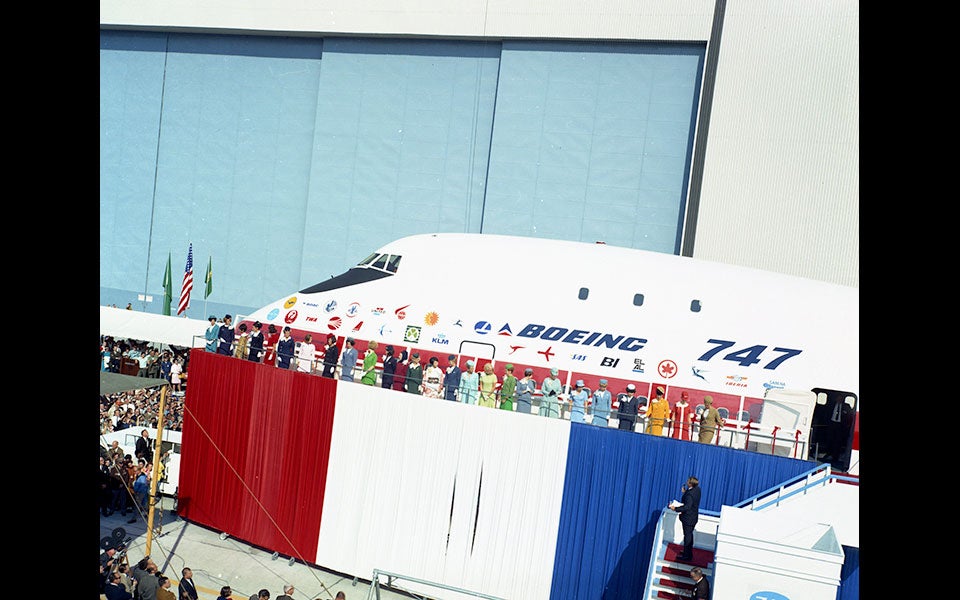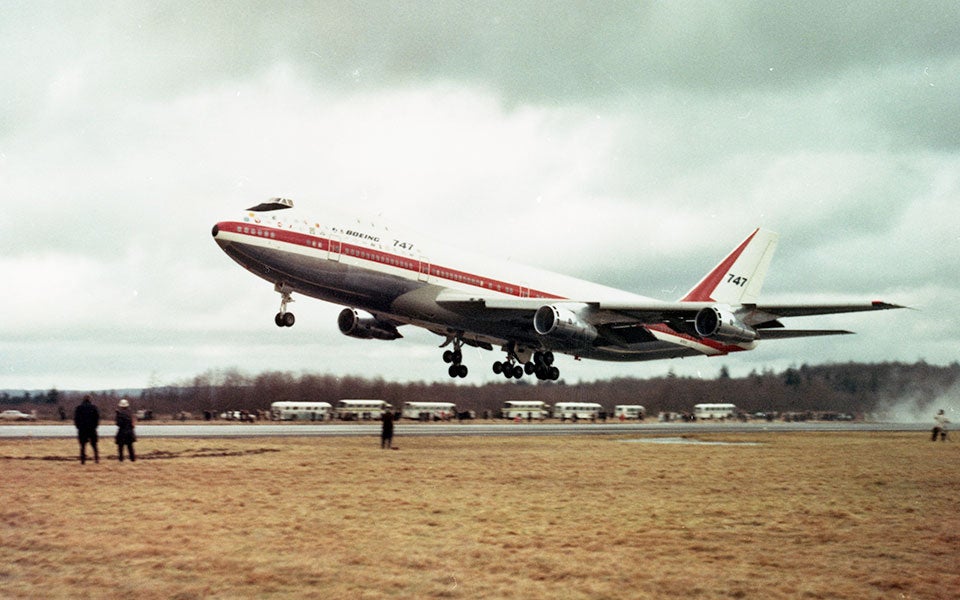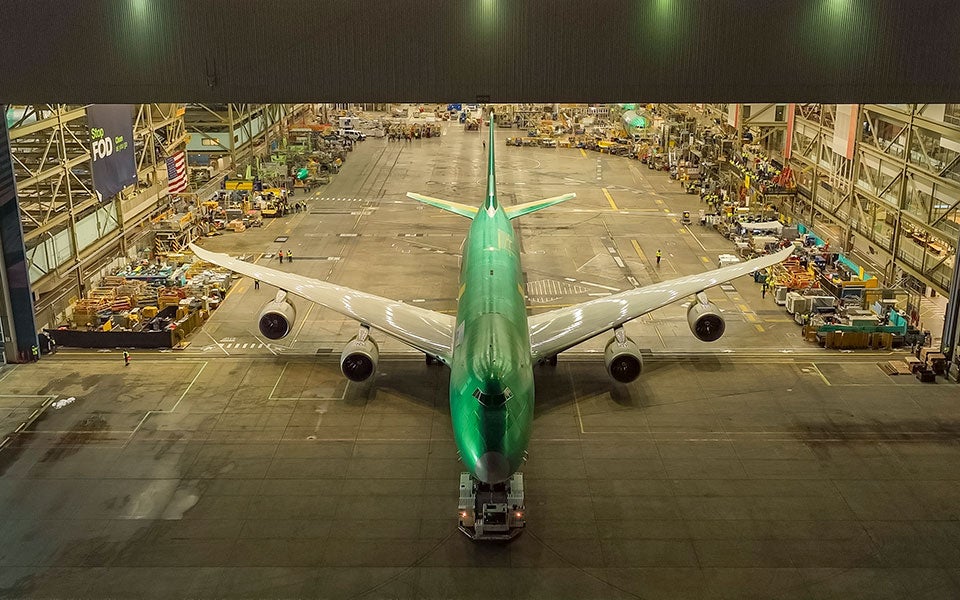The last Boeing 747, the “Queen of the Skies,” has left the building. The line ends on number 1,574.
The iconic jumbo jet was given a celebrity send off Tuesday, with the kind of fanfare worthy of a Hollywood awards show. The final delivery event featured guest speakers, live music, and videos honoring the legacy of Boeing (NYSE: BA) and the closing of a chapter of the aerospace giant’s legacy.
The event was held at the factory in Everett, Washington, where the final 747 was delivered to Atlas Air—with an audience of thousands made up of Boeing employees, former employees, customers, and suppliers looking on. The ceremony, which was live streamed, was also witnessed by thousands of viewers online.
The final delivery began with a procession of flags bearing the livery of the airlines—past and present—that fly 747s, which was recognized as one of the most versatile airframes ever to be built.
The farewell presentation was led by Stan Deal, president and chief executive officer of Boeing Commercial Airplanes. Deal recalled a pivotal meeting between Bill Allen, Boeing’s longest serving president, and Juan Trippe, the founder of Pan American World Airways.
Introducing the last 747! 👑✈️
— Boeing Airplanes (@BoeingAirplanes) January 31, 2023
Here is a look at how we put together the final #QueenOfTheSkies. pic.twitter.com/ngkPWwCTXL
According to Deal, the jet age had begun and people were traveling. Trippe was looking for an aircraft with greater range than the Boeing 707.
“Bill Allen and Juan Trippe were in a mockup of the 747 cockpit and Bill Allen said to Juan, ‘If you buy it, I’ll build it.’ And Juan Trippe said to Bill, ‘If you build it, I’ll buy it.'” Deal said.
The Incredibles
Deal thanked “The Incredibles”—the people who built the first Boeing 747 in a mere 16 months. They were led by Boeing engineer Joe Sutter, who is recognized as “the founding father of the Boeing 747.”
Part of the challenge, said Deal, was that the aircraft was so large—the cockpit was 30 feet in the air—that it needed a new factory. The facilities at King County International Airport/Boeing Field (KBFI) where the Boeing B-17 was built and the factory at Renton Municipal Airport (KRNT) where the 707 went together were not large enough to accommodate the jumbo jet with its four engines and the fuselage wide enough to hold two aisles.
A new factory had to be built. A parcel of land next to what is now known as Snohomish County Airport/Paine Field (KPAE) in Everett was selected, located approximately 23 nm from Boeing Field.
“The new factory involved clearing some 788 acres of forest land and moving 4 million yards of dirt,” said Deal, noting that the first 747 was built while the factory was built around it.

The Legacy of the 747
A host of dignitaries from Boeing and the airlines that fly the 747 as part of their fleet shared stories about the iconic airplane, including what it was like to set eyes on it for the first time in the factory, how impressive it was when you walked up to it, and the sense of awe when you realized that this engineering marvel had been created by some of the finest minds in aviation. Then, there’s how comfortable it was to ride in the passenger compartment, which was described as “being in your living room with 360 or so of your closest friends.”
John Travolta, entertainer and pilot for Qantas Airlines, shared his experience learning to fly the 747, noting that it made learning to fly the Boeing 737 “a breeze.”
John Dietriech, president and CEO of Atlas Air noted, “There is no greater freighter than the 747,” saying that in it, Atlas Air has carried race cars, race horses, medical supplies, and satellites in support of the space program. He then shared the flight plan that the Atlas Air 747 will use to depart Seattle—the waypoints draw a crown with 747 in the center.
During what was a high point for those at the event, Deal called for the hangar doors to be opened. The Atlas Air 747-8 was revealed, emblazoned with a special decal on its nose: “Joe Sutter Forever Incredible.”

Deal concluded the ceremony by reminding the audience that Boeing would continue to support the 747 for decades to come, and that future Boeing designs, including the 777-8F which is touted as a replacement for the 747, stand on the shoulders of “The Incredibles” and the jumbo jet that opened the skies for so many.
History of the 747
The four-engine jet entered the airline world in 1970, sporting the livery of Pan Am. The first flight was from New York to London. The iconic airplane with the hump over the cockpit quickly became synonymous with exotic air travel, as it flew across oceans, taking both people to where they needed or wanted to be.
The 747 is known for its versatility. It is a sturdy cargo hauler. Specially modified models carried NASA’s space shuttle on their backs, while others received interior upgrades for comfort and security, making them the aircraft of choice for leaders of nations.
At the present time, the widebody, twin-engine Boeing 777-X and the 777-8F, the freighter variety, are currently being developed with the idea they will eventually fill many of the roles currently occupied by the 747. The 777-X is said to have the same capacity of the 747-400F but will use less fuel. The 777-X/8F is slated to be in service by 2025.
Today we celebrate the end of production on the 747, the world’s first jumbo jet — a plane that enabled more people to fly farther, faster and more affordably than ever before. #QueenOfTheSkies
— Boeing Airplanes (@BoeingAirplanes) January 31, 2023
Tune in here at 1 p.m. PST: https://t.co/FV3Dmnsph8 pic.twitter.com/BgSJT3RmJP
